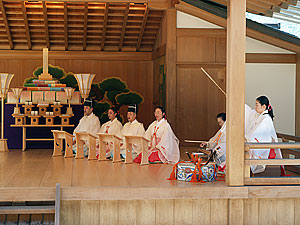
By Bill Roberts
No suits, no ties and no tea ceremony: the monthly service -- Tsukinamisai -- at the Oomoto branch on Amami Oshima was somewhat different from the two dozen I have attended since I began to visit branches in 2001.
The branch on Amami Oshima, a semi-tropical island, proved to be the most exotic of six visits I made in the summer of 2007. From the outdoor service in the garden at Kumamoto (see separate story) to the male yakumogoto player at Osaka to a sing-along at Tsukushi, each branch had its unique flavor, yet all are tied together by Oomoto beliefs and ritual.
During the summer, one of the hottest ever in Japan, I made five official branch visits, and also visited the sacred island of Kamishima for a cleanup day with members of the Harima branch.
I am impressed by the dedication of Oomoto followers wherever I go.
Fukuyama
Small but mighty describes the Fukuyama branch: small amount of floor space, mighty attendance relative to membership.
The shrine is not much wider than a train car. Okay, two train cars, but you get the idea. Along the outside is a narrow tea garden, through which run a narrow brook and a narrow path that lead to the tearoom. As in many branch shrines, the tearoom is attached to the main building, but its formal entrance opens into the garden.
Fukuyama is on Honshu, near the Inland Sea, between Okayama and Hiroshima. It is medium-size among Oomoto branches, but gets large turnouts for Tsukinamisai. When I attended on the first Sunday in July, there were more than 100 in the congregation, including at least 20 children. I was told this was much more than half of the total membership.
The branch places special emphasis on involving children in the service because Fukuyama members believe this is a way to nurture lifelong commitment to Oomoto. Keeping young people interested in Oomoto is a challenge the entire organization is facing.
Many other branches offer baby-sitting services in a room elsewhere in the building when the service is taking place in the shrine. Not in Fukuyama: all the children sit with their parents or grandparents in the shrine; during the service, all children are invited to make the pine bough offering. The day I attended, a girl read from the scriptures.
The reader is the granddaughter of Sumiko Ochi, one of Oomoto’s few female branch chiefs. “I get a lot of help from my husband running the branch,” Ochi told me with a gentle laugh during tea ceremony.
It was the first time I attended a Tsukinamisai where the branch chief played yakumogoto. Ochi has practiced the two-stringed instrument for many years, and leads the four-person ensemble that plays for the service each month.
Osaka
At the monthly service in Osaka, I encountered another rarity: a man, Hiroshi Tani, in the yakumogoto ensemble. Oomoto has no rules about whom may play the instrument; a few men do, but the vast majority of players are women. Until Osaka, I had never seen a man play in a service. I had heard that it happens, but I had never seen it.
The Osaka branch was a big supporter of the traveling exhibit of art works by Oomoto’s Spiritual Leaders in the mid-1970s. The exhibit helped to inform many people in Europe and North America about Oomoto, and led to many interfaith activities, with ripple effects still being felt thirty years later. Osaka is one of Oomoto’s largest and most active branches.
However, on the second Sunday in July 2007, many Osaka members were attending the annual service held on the bluffs overlooking Wakasa Bay in the Japan Sea, where two of Oomoto’s sacred islands are located: Oshima and Meshima, which I wrote about in my book. Even with the competing event, more than 150 attended the Tsukinamisai in Osaka.
The tearoom held a surprise. On display were five sake cups made by Co-Founder Onisaburo Deguchi when he was beginning to experiment with the vivid colors he would use on 3,000 yowan -- scintillating tea bowls during a creative explosion in his last years. I was thrilled to see these sake cups, which were part of Onisaburo’s artistic evolution.
Another treat was the dinner we had at Mimyu, one of Osaka’s well-known noodle restaurants. We had nabe, a pot full of vegetables, fish and noodles cooked on a burner on the table, most often served in winter. I found it a bit too steamy for a humid summer day, but tasty nonetheless. About a dozen members of the branch attended.
However, my most memorable encounter with the Osaka branch came about a month later, when Oomoto holds its Summer Grand Festival, which coincides with the anniversary of Onisaburo’s birth in early August.
As part of the celebration, Oomoto has the Miroku Odori, a folk dance adapted by Onisaburo and performed nearly every night outdoors for about three weeks in late July and the first part of August.
The night before the Summer Grand Festival religious service, Oomoto holds a dance competition for women’s groups from all branches. I don’t know which group won, but my vote would have gone to the ladies of Osaka.
Led by the lively Yoshiko Sakamoto, chief of the Osaka women’s division, they wore traditional straw hats decorated for the occasion, giving their dance troupe a distinctive appearance. With Sakamoto in the lead, the women had some of the happiest feet on the ground that night, dancing round and round the raised stage in the thick air.
Amami Oshima
Amami Oshima, a semi-tropical island 700 miles south of Osaka, is the northern-most isle in the Ryukyu Island chain. Okinawa, on the south end of the chain, is the largest island in the archipelago, and Amami Oshima (“Oshima” means “Great Island”) is second largest. For comparisons, the Isle of Man is a bit smaller than Amami, and the Hawaiian island of Kauai is about twice the size.
The east coast of Amami Oshima, facing the Pacific Ocean, has long beautiful beaches and coral reef. The west coast, facing the East China Sea, has steep cliffs plunging into azure fjord-like bays. Fishing, diving and snorkeling are popular among tourists.
The Oomoto congregation used to be much bigger but is now quite small. The islanders have maintained much of the original character of the place by not letting big resorts build on the pristine beaches. That comes with a price – too few sources of jobs. Young people with ambition must leave the place. Most of those who remain must farm and find some kind of side work.
When we attended the Tsukinamsai we knew we had come to a different place, sort of like Japan but not exactly. The branch building has the distinction of being the only Oomoto shrine surrounded by sugarcane, an important Amami crop. Inside, the two city slickers from Oomoto headquarters were the only men wearing suits and ties.
Elsewhere, Tsukinamisai starts exactly on time. At 10 AM on Amami, the priests were still dressing, and the ritual began about 15 minutes late. This is not a criticism; it merely underscores the different pace of life on Amami. No one seems obsessed with the clock, and no one wears a tie.
Amami is by far the least formal environment I have encountered in Japan. No surprise that they did not have tea ceremony. We did, however, have a smash-bang party that night. The people of Amami like to drink beer, play the jamisen and dance. The jamisen is a smaller version of the shamisen, a lute-like instrument played elsewhere in Japan. The jamisen has three strings and sounds more like a banjo than a lute. The songs are rich and haunting.
At the party, Shunrou Kumamoto, the branch chief, played the jamisen, and everyone danced. We heard a special performance by a 10-year-old granddaughter of Mr. and Mrs. Kusuda, longtime Oomoto followers who donated the land for the shrine. The granddaughter had recently won a children’s competition on the instrument. At one point, her grandmother, Setsuko Kusuda, sang with her.
The Amami people stand on no formality. When they were ready to shut down the party, they not so subtly told us they were doing the “it-is-time-for-guests-to-go” dance. As we departed for our seaside hotel, some of the men danced on the veranda of the shrine to celebrate our leaving.
A few miles across the coral reef east of Amami Oshima is the even smaller island of Kikai-jima, site of an Oomoto sub-branch and an important shrine. The day after the Tsukinamisai, we boarded a Japan Airlines flight to this tiny island. They’re trying to get the flight listed in the Guinness World Records as the shortest, regularly scheduled commercial flight on the planet – ten minutes from takeoff on Amami’s airport to touchdown on Kikai.
At the party the night before, I asked why we couldn’t just take a boat. Using a chalkboard one of the members sketched a map and explained that the east side of Amami is bounded by coral reef with no place for a harbor. To take a boat to Kikai-jima, one must drive to the west side to catch the ferry, and then a three or four hour cruise. Ten minutes, or four hours: not a hard decision. We flew to Kikai, as do most visitors.
Kumamoto, the Amami branch chief, came with us to Kikai and served as our host – with help from four Kikai female members -- for a day that included a visit to the Oomoto shrine, sightseeing and lunch at the home of a retired Japanese Navy cook – who really knew how to cook. The important reason for the visit was to view the Oomoto shrine, called Miyabaru Yama. According to Onisaburo’s model of the world, it is the polar opposite of an important shrine in Hokkaido.
Tsukushi
The last branch visit of the summer was to Tsukushi, on the north end of Kyushu, across the strait from the southwest end of Honshu. Many Oomoto branches use the ancient name of the area as the branch name, and this is the case with Tsukushi, which today is known as the Kokura area for the city by that name.
Tsukushi is a large branch, and the September service was well attended, with more than 100 present. The followers at Tsukushi are especially interested in the Middle East, which is important in many of Onisaburo’s writings. The night before the service, we met at the shrine with about twenty members for a dinner, and an informal discussion about the Middle East and related topics.
Hiromi Yano, deputy chief of the Oomoto International Department, who accompanies me on my branch visits, has traveled widely in the Middle East, organizes talks by Middle East experts for Oomoto, and lectures and writes about the region. Because I spent a year of college in Israel, studied Hebrew and Arabic, and directed newspaper coverage of the region, I know a little about the situation, too. At Tsukushi’s request, I also spoke on this topic the next day in my speech after the service.
As much as I enjoy formal dinners hosted by the branches I visit, I prefer these less informal events, where we have a simple meal at the shrine, and can sit and talk about whatever topics are of interest.
By the time we visited Tsukushi, I had already experienced a busy summer of branch visits and other Oomoto events, enveloped in one of the worst heat waves in Japan’s history. In mid-August, the newspapers blazed with headlines about record deaths and hospitalizations from the heat.
At Tsukushi, with the sliding doors on the side of the five-year-old shrine wide open, a gentle breeze wafted through the building, a hint of late summer evolving into early fall. Following the ritual, the yakumogoto ensemble returned to the room and took center stage. Someone turned a big whiteboard around with words in Japanese for everyone to see, and announced we would sing while the yakumogotos played.
I’ve been to branches where they had a special yakumogoto musical performance after the ritual, and I’ve been to branches where a choir sang after the ritual, but I had never witnessed a sing-along with the ancient strains of the yakumogotos. Oomoto people love to sing, and the Tsukushi members gave their best vocal effort as we all enjoyed the late summer breeze, a harbinger of mercifully cooler times ahead.
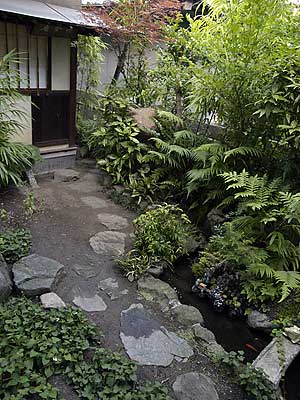
The narrow tea garden at the Fukuyama branch.
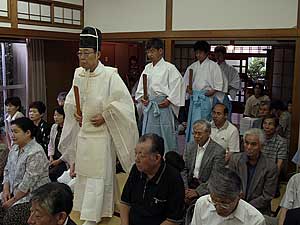
The monthly service is well attended.

Cramped quarters.
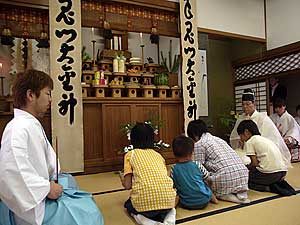
The branch invites all children to make the pine bough offering.
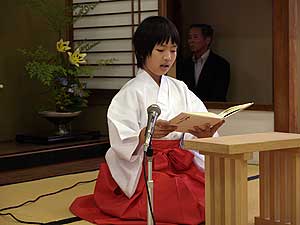
The branch chief’s granddaughter reads the scripture.
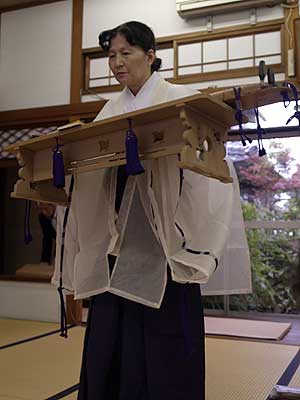
Sumiko Ochi, branch chief and lead yakumogoto player.

Osaka is one of Oomoto’s largest branches.
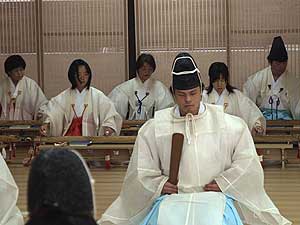
The yakumogoto ensemble included a man, which is unusual.

Hiroshi Tani, yakumogoto player.
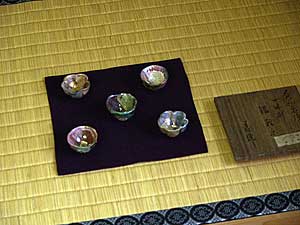
Five of Onisaburo Deguchi’s sake cups with the vivid colors he would use on his tea bowls.
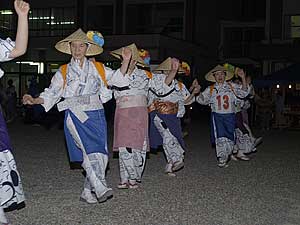
The Osaka women at the Miroku Odori in August.

Yoshiko Sakamoto, chief of the Osaka women’s division.

Amami is the only Oomoto branch in the middle of a sugarcane field.

The branch sits on land donated by the Kusuda family, who live across the street.

The white priest robes are in stark contrast to the dark wood shrine.

Shunrou Kumamoto, branch chief, plays the jamisen for the party.
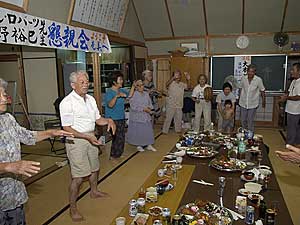
Everyone is ready to dance.
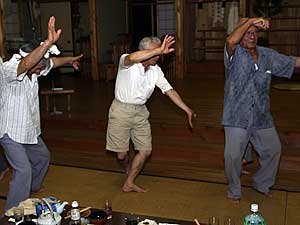
Amami style toe-tapping.
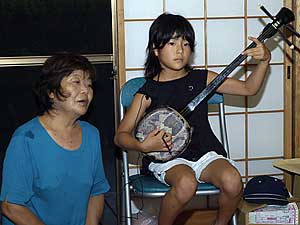
Mrs. Kusuda sings with her granddaughter.
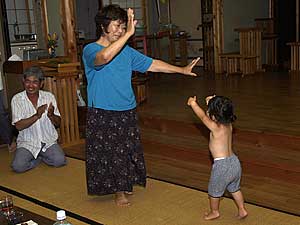
Later, Mrs. Kusuda dances with another granddaughter.
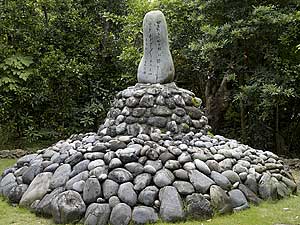
Miyabaru Yama shrine on Kikai-jima.
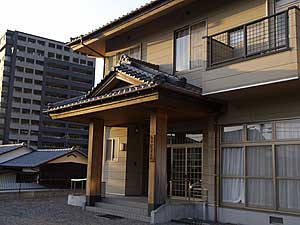
The Tsukushi branch building in Kokura is about five years old.
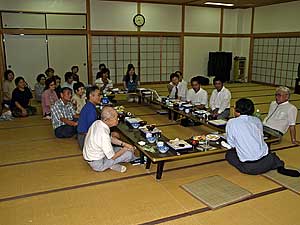
Hiromi Yano (back to camera) leads discussion on the Middle East.
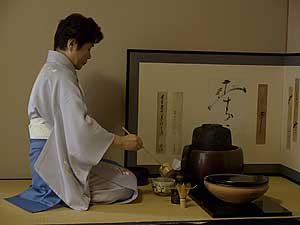
The tea ceremony is held before the monthly service.
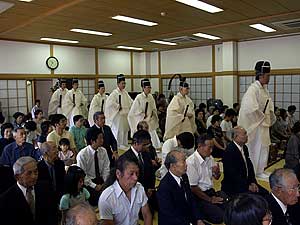
Service begins in Tsukushi.
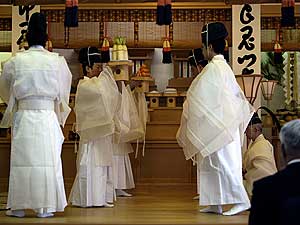
Kensen—the priests make offerings of vegetables, fruits, fish and rice.

A yakumogoto performance with sing-along is held after the service in Tsukushi.
New Contents Thu, May 20, 2010
- Oomoto participates in Sant’Egidio conference : Dialogue among religions and cultures : On divided island nation of Cyprus By Bill Roberts
- Photo Album : Portraits of three branches: Shoko, Tanegashima and Aomori By Bill Roberts
- Oomoto FAQ
- A Letter from Oomoto : Of mountains and myths By Bill Roberts
- Polyglot poem festival The Utamasturi is going international — what’s next? By Bill Roberts
- Ethics education program captures the spirit of Bankyo Dokon By Bill Roberts
- A Letter from Oomoto : A year’s worth of adventure in a summer of branch visits By Bill Roberts
- In Kumamoto, it’s all about water – and fire By Bill Roberts
- A speech by Nevada Taylor at the Kii Branch in Wakayama Prefecture on April 13, 2008.:An Encounter With Oomoto Through Aikido
- Utamatsuri, Poem Festival, in Tokyo(on April 17, 2008)
- A speech by Neil Ryan Walsh at the Kobe branch on Mar. 9th, 2008.:Planting the Seeds of the Soul
- Meeting with the Fifth Spiritual Leader of Oomoto, Madame Kurenai Deguchi by Neil Ryan Walsh
- A speech by Neil Ryan Walsh at the Nagoya branch on Feb. 17th, 2008.:The Japanese Arts beyond National Boundaries
- To the Oomoto branch in Nagoya: City of Eel and Toyota by Neil Ryan Walsh
- A Speech by Nissim Ben Shitrit, Ambassador of Israel on the occasion of the Oomoto Setsubun Grand Festival in Ayabe February 3rd, 2008 : Japan and Israel : Two Lands Balancing the Needs of Traditional Culture and Modern Life. r
- A permanent memorial to Onisaburo (A Speech at the Autumn Grand Festival , November 6, 2007 : )By James Parks Morton, Founder and Chair, Emeritus of The Interfaith Center of New York
- Israel, Palestine and the Power of Poetry(Oomoto believes small efforts can have lasting ripple effects on people and peace)By Bill Roberts
- “Something Great”(This genetics pioneer, a friend of Oomoto, offers a clue to the mystery of life)By Bill Roberts
- Kamishima Cleanup (Harima branch members regularly visit this sacred island to keep the shrine tidy)By Bill Roberts
- Kyotaro Deguchi was one of six recipients of the 2007 James Parks Morton Interfaith Award
What is Oomoto?
- What is Oomoto?
- Spirtual Centers
- Founders and Spiritual Leaders
- History
- Organization and activities
- Teachings and scriptures
- Art Works of Founders and Leaders
Opinions[Archive]
- Statement of regret for the outbreak of war against Iraq (March 20,2003)
- Jinrui Aizenkai dispatched the "Urgent Appeal for a World (Global) Crisis" on March 14.
Grappling with Bioethics[Archive]
- Oomoto’s support for abolishing the death penalty (12, June 2003)
- The Oomoto Foundation protests any birth of a human clone baby. (5, January 2003)
- OOMOTO'S VIEW REGARDING JAPAN’S PERMITION TO THE RESERCH OF HUMAN EMBRYONIC STEM CELLS (ES cells)(12, June 2000)
Vistor’s Review[Archive]
- A speech by Bill Roberts at the Oomoto branch in Hiroshima after its monthly service on March 18, 2007:Encounters with war and peace
- How Bankyo Dokon changed one life by Linda Macphee
- A speech by Bill Roberts at the Hokuriku (Kanazawa) branch on Dec. 3, 2006:Ritual and myth -an encounter with ‘divine madness’
- A speech by Bill Roberts at the Himeji Cultural Center on Feb. 25, 2007:Mesmerized by the Japanese Arts
- A speech by Bill Roberts at the Kobe branch on Feb. 11th, 2007.:There are just human tears and human joy
- A Speech on the occasion of the Oomoto Setsubun Grand Festival in Ayabe February 3rd, 2007 : Egypt's role in Middle East peace
- Keynote Speech for the 28th World Federation Japanese Religionists Conference for World Peace in Tokyo (at Kokugakuin University, Novermber 29, 2006):Vision for Peace in the Middle East By Dr. Munther S. Dajani, Professor Dean, Faculty of Arts, Al Quds University, Jerusalem
- A speech to the Kyoto branch:Spiritual adventures in researching Oomoto leaders
- A Speech at The Oomoto Foundation on Monday, November 6, 2006 : Jordan's role in Middle East By Samir Nouri, Ambassador of the Hashemite Kingdom of Jordan
- A letter from Oomoto:The Young People of Tottori
- A speech by Bill Roberts on the occasion of the dedication ceremony for the new shrine of Tottori Branch By Bill Roberts Oct. 8, 2006
- A speech by Bill Roberts at the Oomoto branch in Hiroshima after its monthly service on March 18, 2007:Encounters with war and peace
- How Bankyo Dokon changed one life by Linda Macphee
- A speech at Setsubun : A Portrait of Oomoto By Bill Roberts Feb. 3, 2006
- New Publication ! By Bill Roberts Feb. 3, 2006 A Portrait of Oomoto
you can read this book in html => http://www.jinruiaizenkai.jp/English/en-kolumno/en-bill/en-sugao/billbook1en.html
E-mail below to order brobert1@ix.netcom.com
Current Topics
- Prayer Offering and World Religious Forum II
- Living the art of dialogue
- Kyotaro Deguchi was one of six recipients of the 2007 James Parks Morton Interfaith Award
Books
Online Books
- Divine Signposts by Onisaburo DEGUCHI
- The Creation of Meaning by Hidemaru Deguchi
- Bankyo Dokon(Seventy years of Inter-Religious Activity at Oomoto)
- Nao Deguchi — A Biography of the Foundress of Oomoto
- The Great Onisaburo Deguchi published by Aiki News
- Bankyo Dokon Seventy Years of Inter-Religious Activity at Oomoto
- Insearch of Meaning
- Nao Deguchi A Biography of the Foundress of Oomoto
- A Portrait of Oomoto By Bill Roberts
Oomoto international Archive
- The History of Oomoto (Jan.– Mar. 1980 — Apr.– Jun. 1982)
- The Ancestors; Friends or Foes? (Apr.– Jun. 1987)
- Tsukinamisai; The Sabbath of Shinto (Jan.– Jun. 1983)
- The Poem Festival at Oomoto; An Ancient Rite Lives Again (Oct.– Dec. 1981)
- Purification of the Universe ; Oomoto's Setsubun Festival (Apr.– Jun. 1981)
Links
Flowers at Ten'on-kyo & Baisho-en (photographs)
Contact
All rights reserved : the Oomoto Foundation Produced by the Netinformational Commission
Since : Mar. 7.1998 Last Update : Thu, May 20, 2010
E-mail : webmaster@oomoto.or.jp
Top Page Nihongo Esperanto Português Roomazi



